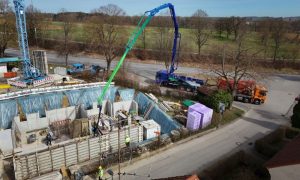Terex takes Space Shuttle Discovery to its final frontier
US contractor J F Lomma has helped to deliver Space Shuttle Discovery safely to its final resting place at Washington’s famous Smithsonian Institute. Discovery, the most travelled shuttle over its 27 years of operation, landed at Washington Dulles International Airport on 17 April carried on the back of the specially designed Boeing 747 Shuttle Aircraft […]

US contractor J F Lomma has helped to deliver Space Shuttle Discovery safely to its final resting place at Washington’s famous Smithsonian Institute.
Discovery, the most travelled shuttle over its 27 years of operation, landed at Washington Dulles International Airport on 17 April carried on the back of the specially designed Boeing 747 Shuttle Aircraft Carrier (SAC).
Lomma and the United Space Alliance crews methodically hoisted the 196,400 (89,085 kg) shuttle off of the 747 SAC.
“You cannot describe what it’s like to be part of space shuttle history,” said Frank Signorelli, crane and rigging manager for Lomma. Josh Barnett, field service representative for Terex Cranes, who was on site to support Lomma on the lift, added, “It was a one-of-a-kind experience.”
Serving the New Jersey and New York area as well as markets from coast to coast and select international markets, Lomma has seen its share of historic work. This includes supplying crane and rigging services for construction work that continues today at the World Trade Center.
For Lomma, planning for this job started nearly two years ago when company officials first considered bidding for the job. NASA was very specific in what equipment was required for the work.
“The bid called specifically for the Terex CC 2800-1 as the primary crane to do the pick as well as all of the other supporting cranes and equipment,” said Frank Signorelli, crane and rigging manager for Lomma.
Part of the reason for this lies with NASA’s experience with this crane model for a similar pick. Lomma purchased the CC 2800-1 which was on rent with a customer in Quebec. Upon returning to the yard, the crane was rigged to make sure the right components were in place for the job. “We ran the crane in our yard,” says Signorelli. “The (IC-1) computer screen is extremely user friendly and self-explanatory. It’s not a complicated crane to operate.”
When it came time for the shuttle pick, there was very little left to question. “NASA had everything marked out on the ground – positioning for the Terex crane, the supporting crane and the 747,” explained Signorelli.
The CC 2800-1 crawler crane was equipped with a 177-ft (53.9-m) main boom and a 98-ft (29.9-m) Superlift mast. Lomma used 352,000 lb (159,665 kg) of main counterweight with no central ballasts. Superlift counterweight of 275,000 lb (124,738 kg) was added to the tray 50 ft (15.2 m) from the crane base. “Normally, a lift like this would require only 220,000 lb (99,790 kg) on the Superlift, but NASA’s additional safety factor required an extra 55,000 lb (24,948 kg) on the tray,” explained Barnett.
NASA engineers used calculations from the CC 2800-1’s IC-1 controls to map out the final position of the crane. “They wanted the connection between the shuttle and our crane to be at 112 ft (34.1 m),” said Barnett, “and the actual distance in the field from the center of the crane to the hook was 111.9 ft (34.1 m). They were impressed with IC-1’s accuracy.”
Slowly and with precision the pick began with the weight shifting and then transferring to the cranes as the brackets were removed from the shuttle and carrier. After the shuttle hovered a safe distance over the carrier, a pushback tug backed it from underneath the shuttle. The shuttle was then lowered to within a few feet of the ground. Auxiliary hydraulic power lowered the shuttle’s landing gear for a final time before the cranes lowered it to the ground.
“The subtle movements offered by the CC 2800-1’s hydraulic system definitely helped with this pick,” says Barnett. “If the crews only needed 0.5 inch (12.7 mm) of movement, the crane was able to give it to them.”
A few days later, Discovery was towed to the Smithsonian and replaced the Space Shuttle Enterprise, which had been on display inside the James S McDonnell Space Hangar since 2003. This prompted a second pick and final move of the Enterprise to its new home in New York.
Under clear weather conditions and wind speeds flirting with NASA’s threshold, Lomma began the pick just before midnight. Similar with the Discovery project at Dulles, careful planning and constant communication allowed the pick to be completed successfully.
By 7 am EDT Sunday, May 13, Enterprise was loaded onto a special wheeled transport and moved into a hangar at JFK. It embarked on a three-day journey on the Hudson River in early June. Its final destination is the Intrepid Sea, Air and Space Museum in New York City.
“It’s indescribable to be a part of history,” commented Signorelli. “This is something I was able to take my kids to see, and a story they will tell their children.”
Read the full story in CMME’s upcoming July Issue. Out 1 July.










